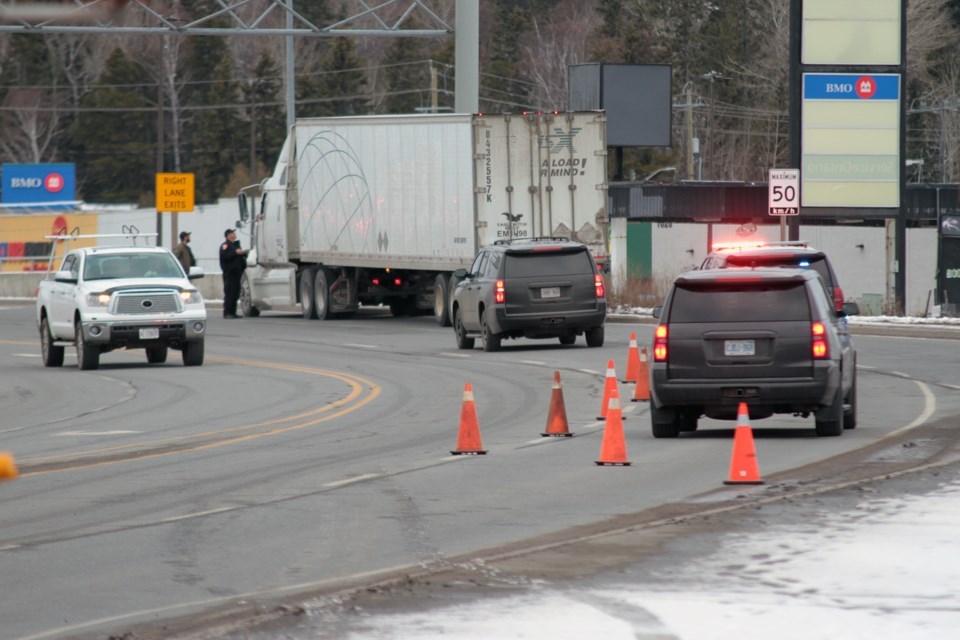THUNDER BAY – Officials say the number of fatal collisions in the city would decrease if the city implements a designated truck route.
“Using the predictive models and the collision data, there is an overall reduction in fatal injury collisions,” engineering director Matthew Miedema told council on Monday.
According to Miedema, the number of fatalities on Dawson is expected to be reduced by two over 20 years.
A collision investigator with the Thunder Bay Police Service was unequivocal in his agreement that the proposed change would reduce fatalities, particularly on Dawson Road.
If passed, the proposed truck route would divert cross-country transport trucks from Dawson and Arthur Street. An estimated 1,300 trucks per day would be shifted off Dawson and onto Highway 11/17 where it traverses the city, according to the city's report.
At-large Coun. Mark Bentz.raised concerns on Monday about the impact that increased truck traffic would have on the Thunder Bay Expressway.
“We're essentially taking thousands of trucks off what is essentially a bypass around our city and moving it to a higher speed, higher volume, essentially an arterial,” said Bentz.
“It's not an expressway; there are no interchanges. There are three potentially dangerous intersections that trucks will now be encountering on this roadway with thousands of cars.”
Bentz's concern is with the cross traffic at the intersections of Red River Road, John Street, and Oliver Road, particularly Oliver's steep slope for those people travelling west.
Data suggests that signalized intersections tend to show fewer severe collisions over time compared to unsignalized intersections, said traffic engineer Margaret Parkhill with Arcadis Professional Services
“So, while the intersections on Highway 11/17 have higher volumes, they are more likely to be signal-controlled than those on Dawson and Highway 102,” Parkhill said.
Dawson stands out with a high rate of transport truck collisions due to several horizontal curves where nearly half of the accidents happen, especially in the winter, Parkhill said.
Bentz suggested that moving truck traffic from a 50 km/hr road on Dawson to a 90 km/hr road on Highway 11/17 would increase the impact and severity of collisions.
“I know the speeds are much higher on here, and I don't know how your models attribute the energy attributed to a collision. It goes up by a factor of four if you double the speed. And, of course, we all know that energy is what causes fatality. So, I mean I can't look inside your black box,” Bentz said.
Despite the speed limit on Dawson Road, Sgt. Sal Carchidi, with the Thunder Bay Police Service, said police see “significant commercial traffic” exceeding 90 km/hr coming into the city.
Carchidi said that as a collision investigator, his role is to investigate serious injuries or deaths in the city resulting from collisions.
“Tractor-trailer unit travelling between 80 and 90 km/hr has a stopping distance, once the driver sees a threat, has to react to it, apply his brakes, and stop, a loaded tractor-trailer takes between 147 and 190 metres to stop,” Carchidi said.
He noted that Dawson has seen a significant increase in pedestrian traffic with new residences and multi-storey buildings being added to the area.
“A lot of those, specifically senior people, we're seeing walking on the roadway, are crossing Dawson Road. So, when they see a transport or even a passenger car travelling at a rate of speed, they anticipate that they can cross the road with enough ample time to do it safely.
"When those trucks specifically are travelling at 70, 80, 90 kilometres per hour, not only their velocity, the distance they're travelling in a certain amount of time, but their stopping distance is significantly affected,” Carchidi said.
“There is a direct relation to speed, and again, like Coun. Bentz said, the energy that is significant when we're dealing with commercial truck traffic.
"In my experience — and the city police have joined me in this position — we will save lives by removing trucks from Dawson Road, specifically the portion of Dawson Road that the city police enforce.”
Bentz also had questions about the predictive modelling used in the report and the margin of error for its predictions.
Parkhill said there “certainly is a margin of error,” however, when compiling the data, they took “a conservative approach” in predicting the volume of traffic on Dawson under the assumption that traffic volumes stayed the same over the next 20 years.
She noted that the Ministry of Transportation designed the predictive models and they are used worldwide.
“We used models that are made in Ontario and reflect Ontario driving behaviour, Ontario conditions, and Ontario road design standards as well. So, the models they take into account the road design, the traffic volumes, and what we've done is combine mid-block road models with the intersection road models,” Parkhill said.
“So that means using similar intersections from around Ontario, that's how we are building the predictive model to forecast what the future collision performance might be as the volumes are changing at the intersection or at the mid-block location. Now we're adding that all together.”
